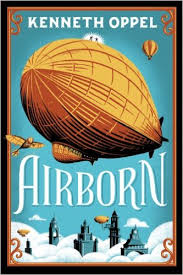It’s a rewarding question to ask, especially of a book in a genre which is not particularly this reviewer’s cup of tea why such a book won five coveted awards and elicited so much praise. This is the case with Kenneth Oppel’s Airborn, an alternate-history, adventure fantasy. Though I get where the description is coming from – half of the story set in an airship with all its cogs, pipes, goggles and engine noise – classifying the work as steampunk is a bit of a stretch.
It is a story which unfolds in and borrows from the late Victorian or early Edwardian period. The era’s sensibilities are all present, including a fascination for all things flora and fauna, a divide between the privileged rich and the struggling poor, the seeds of the suffragette movement and, of course, the well oiled, steam engine of the industrial revolution barreling down the tracks. Oppel transforms his work into fantasy when he animates the romantic idealism and imaginative visions of the era into mechanical and living and breathing characters.
But back to our question: What makes this work so good?
 For one, as described above, setting the story in a genuine historical period, and revamping that period into an alternative reality by animating some of the era’s qualities and imaginative leaps is a very clever idea. Writer, let this be a lesson; it’s downright prescriptive. Choose an era. Read up on it. Identify the epoch’s realities and limitations and its dreams and visions. Build an alternate world on those foundations and you will be well on your way to a project in the alternate history genre.
For one, as described above, setting the story in a genuine historical period, and revamping that period into an alternative reality by animating some of the era’s qualities and imaginative leaps is a very clever idea. Writer, let this be a lesson; it’s downright prescriptive. Choose an era. Read up on it. Identify the epoch’s realities and limitations and its dreams and visions. Build an alternate world on those foundations and you will be well on your way to a project in the alternate history genre.
Secondly, the work is clean – snap, crackle and pop, clean. Nothing gets in the way of the story, not a plot point, not a weakly drawn character, not over-the-top, to-the-author-pointing vocabulary, not unnecessarily convoluted sentence structure, nothing. The book flows, man. And glide along it does, as if a skiff down a river where around each bend a new rapid or a heart-stopping encounter with wild beasts appears, all the while with the thundering climatic waterfalls threatening ahead in the distance. Reason number three: Airborn is a page turner.
Thirdly, Airborn’s style is consistent. (For more discussion on style see The Red City by Mark Hadley) Sampling the vocabulary and sentence structure was like visiting the pages of a history book or touring a historical movie set. The settings were impeccably painted; the dialogue researched and executed in the language of the target period; the characters were consistently outfitted in period costumes; and not one character was accidentally spotted slipping a contemporary idiom or sporting twenty-first century paraphernalia.
Not two pages into the first chapter the story launches the reader into a hair-raising rescue, through which Oppel introduces Airborn’s characters, its epochal setting, and its romantic (in the literary sense) atmosphere. Airborn lifts the reader in a hot-air balloon and never touches land till it’s finished with you. That’s what ‘they’ all say: grab’em from the first page.
Number Five: the technical vocabulary doesn’t seem contrived and is loads of fun to read. From hydrium (I had to look this one up, believing it to be a gas I missed hearing about – it isn’t. It’s made up.) to axial catwalks (not made up) and hopping snakes (I’m pretty sure…), I sampled each one with relish.
Six. There’s a romance (the relational type) and a crime and a mystery, topped off with a dollop of fantasy – in a children’s book. Check your stats. That almost covers 90% of the book-lover market. It’s the irresistible phenom of butter and sugar.
The fact that I am on my seventh selling characteristic of this book, is the seventh reason this book appeals. Oppel has written, with the help of his publisher, a work that has many skillfully realized attributes.
I could go on and describe the creative metaphorical language, such as, ‘the sky is scalloped with clouds’, ‘aswirl’ (I like that word), ‘while Miss Simpkins had been lurching about on her high heels’ (cue laugh) or highlight its economical sentence structure and the ease with which Oppel introduces characters like precisely cued entrances of characters in a stage play, but I won’t.
Suffice to say here is a book that in most of its execution merits the awards it received. There are a couple of glitches where the story over-stepped believability, but they cannot be discussed without dropping a spoiler. But they are too few to matter, anyways. And sparring with its debatable philosophical premise of self-determination is not aligned to my point.
Writer. Read this book. Follow its example in its technical achievements. You will be a better writer.
